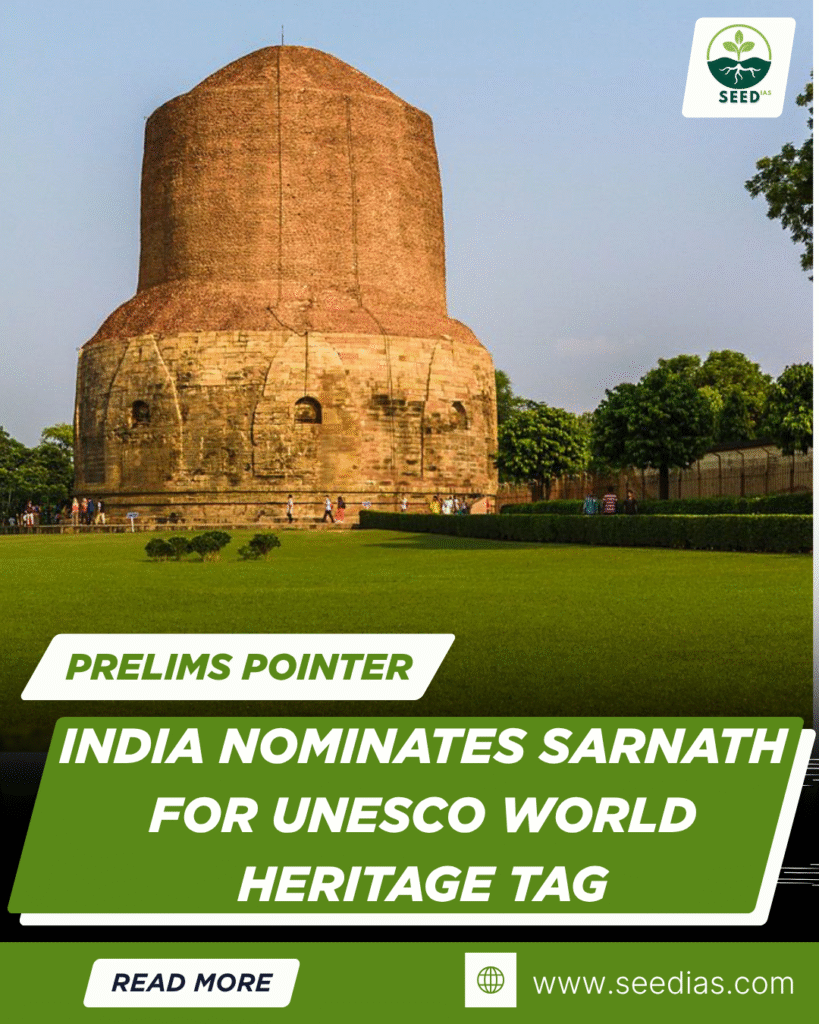Why in NEWS
India has nominated the Ancient Buddhist Site, Sarnath for UNESCO World Heritage List under the 2025–26 nomination cycle. Sarnath has been on UNESCO’s tentative list since 1998.
Key Concepts/Terms
| Term | Explanation |
|---|---|
| UNESCO World Heritage Site | A cultural or natural site listed by UNESCO as having Outstanding Universal Value. |
| OUV (Outstanding Universal Value) | A standard that defines the global significance of a site for present and future generations. |
| Tentative List | A list of sites that a country intends to nominate in the future. |
| Dhammachakkappavattana | Buddha’s first sermon, delivered at Sarnath. |
| ASI | Archaeological Survey of India, nodal agency for heritage matters in India. |
News Simplified for UPSC
- Location & Importance: Sarnath is located near Varanasi in Uttar Pradesh. It is the site where Gautama Buddha delivered his first sermon after attaining enlightenment.
- Names & Significance: Also known as Rishipatana or Mrigadava, modern name ‘Sarnath’ is derived from ‘Saranganatha’ (Lord of the Deer).
- One of Four Key Buddhist Sites: Along with Lumbini, Bodh Gaya, and Kushinagar, it marks the most important milestones in Buddha’s life.
- Architecture Timeline: The site showcases architectural styles from Mauryan to Gahadavala periods.
Monument Groups at Sarnath
| Group | Notable Structures | Features |
|---|---|---|
| Group A | Chaukhandi Stupa | Octagonal Mughal tower built in 1588, commemorates Humayun’s visit. |
| Group B | Dhamek Stupa, Dharmarajika Stupa, Ashokan Pillar | Sites linked to Buddha’s first sermon, Ashokan edicts, and Buddha’s relics. |
Historic Restoration and Invasions
| Period | Contribution |
|---|---|
| Mauryan (Ashoka) | Promoted Buddhism; built stupas and monasteries. |
| Gupta & Kushan Eras | Restored structures; added intricate carvings and frescoes. |
| 11th Century | Attacked by Mahmud of Ghazni; restored by Mahipala (Pala dynasty). |
| Gahadavala Dynasty | Last major monument, Dharmachakra Jina Vihara, built by Kumaradevi. |
Excavation and Museum Heritage
- Alexander Cunningham (1834–36): First scientific excavation of Sarnath.
- Friedrich Oscar Oertel (1904–05): Excavated the Lion Capital (India’s National Emblem).
- Sarnath Museum: Houses the Lion Capital and important Buddhist artefacts.
- Mulagandha Kuti Vihar: Modern monastery with frescoes depicting Buddha’s life.
UNESCO World Heritage Designation Process
| Step | Description |
|---|---|
| Tentative Listing | Site must first be added to country’s tentative list. |
| Nomination Dossier | Detailed dossier submitted to World Heritage Centre. |
| Evaluation | By ICOMOS (cultural), IUCN (natural), ICCROM (technical). |
| Final Decision | Made by World Heritage Committee (India is a member till 2025). |
Criteria for UNESCO World Heritage Tag
- Must demonstrate Outstanding Universal Value (OUV).
- Must meet at least 1 of 10 criteria, covering cultural, natural, or mixed significance.
- Criteria were unified in 2005 into a single list.
In a nutshell
Sarnath = Sermon + Stupa + Symbol of Emblematic India
Mnemonic Code: “4S” → Sarnath – Sermon – Stupas – Symbol (Lion Capital)
Prelims Questions
- Which of the following monuments at Sarnath was originally built by Emperor Ashoka?
A. Chaukhandi Stupa
B. Dhamek Stupa
C. Dharmarajika Stupa
D. Mulagandha Kuti Vihar - Which Buddhist site marks the place where Buddha delivered his first sermon?
A. Lumbini
B. Bodh Gaya
C. Sarnath
D. Kushinagar - Which of the following pairs is correctly matched?
A. ICOMOS – Natural Sites
B. ICCROM – Technical Expertise
C. IUCN – Cultural Sites
D. World Heritage Centre – Final Decision Authority
Prelims Answers with Explanation
| Q | Answer | Explanation |
|---|---|---|
| 1 | C | Dharmarajika Stupa was built by Ashoka to enshrine relics of Buddha. |
| 2 | C | Sarnath is where Buddha gave his first sermon, known as Dhammachakkappavattana. |
| 3 | B | ICCROM offers conservation training and technical advice; ICOMOS = cultural, IUCN = natural. |
















